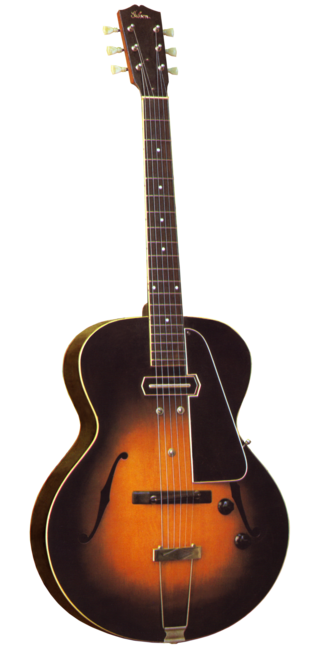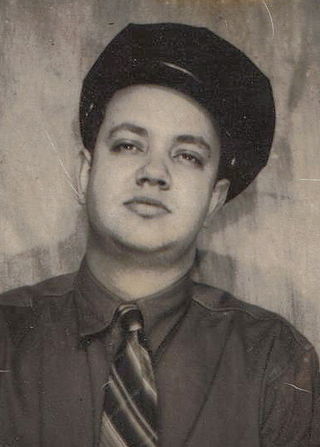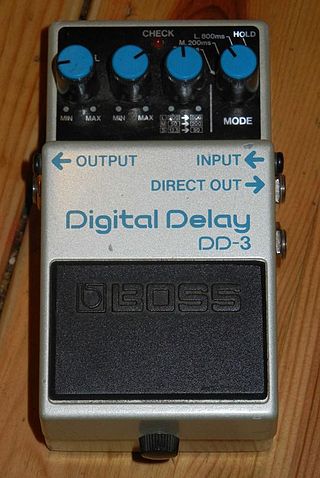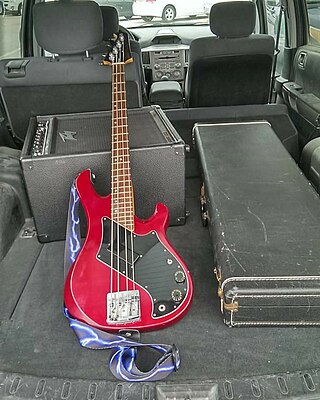Related Research Articles

An effects unit, effects processor, or effects pedal is an electronic device that alters the sound of a musical instrument or other audio source through audio signal processing.

Winfield Scott Moore III was an American guitarist who formed The Blue Moon Boys in 1954, Elvis Presley's backing band. He was studio and touring guitarist for Presley between 1954 and 1968.

A single coil pickup is a type of magnetic transducer, or pickup, for the electric guitar and the electric bass. It electromagnetically converts the vibration of the strings to an electric signal. Single coil pickups are one of the two most popular designs, along with dual-coil or "humbucking" pickups.

A semi-acoustic guitar, also known as a hollow-body electric guitar, is a type of electric guitar designed to be played with a guitar amplifier featuring a fully or partly hollow body and at least one electromagnetic pickup. First created in the 1930s, they became popular in jazz and blues, where they remain widely used, and the early period of rock & roll, though they were later largely supplanted by solid-body electric guitars in rock.

The Gretsch 6120 is a hollow body electric guitar with f-holes, manufactured by Gretsch and first appearing in the mid-1950s with the endorsement of Chet Atkins. It was quickly adopted by rockabilly artists Eddie Cochran, Duane Eddy, and later by Eric Clapton, Brian Setzer, Reverend Horton Heat, and many others. Pete Townshend received one as a gift from Joe Walsh in 1970, which he would later use on recordings for Who's Next and Quadrophenia. Poison Ivy Rorschach of The Cramps notably played a 1958 Gretsch 6120, which she bought in 1985. She said it was her favourite guitar to play. After George Harrison played Gretsch Country Gentleman and Tennessean models, Gretsch found that they could scarcely keep up with demand.
Gretsch is an American company that manufactures and markets musical instruments. The company was founded in 1883 in Brooklyn, New York by Friedrich Gretsch, a 27-year-old German immigrant, shortly after his arrival to the United States. Friedrich Gretsch manufactured banjos, tambourines, and drums until his death in 1895. In 1916, his son, Fred Gretsch Sr. moved operations to a larger facility where Gretsch went on to become a prominent manufacturer of American musical instruments. Through the years, Gretsch has manufactured a wide range of instruments, though they currently focus on electric, acoustic and resonator guitars, basses, ukuleles, and drums.

Joseph Raymond Butts was an American inventor and engineer best known for designing several devices that influenced the evolution of electrified music, in particular those used with the electric guitar. Most notably, Butts is the inventor of the EchoSonic, a guitar amplifier with a built-in tape echo, and the FilterTron, the first humbucker guitar pickup. He was active in other fields from studio equipment maintenance to sound engineering, and had intimate working relationships with people such as Sam Phillips at Sun Studios and Chet Atkins.

Delay is an audio signal processing technique that records an input signal to a storage medium and then plays it back after a period of time. When the delayed playback is mixed with the live audio, it creates an echo-like effect, whereby the original audio is heard followed by the delayed audio. The delayed signal may be played back multiple times, or fed back into the recording, to create the sound of a repeating, decaying echo.

The Echoplex is a tape delay effect, first made in 1959. Designed by Mike Battle, the Echoplex set a standard for the effect in the 1960s—it is still regarded as "the standard by which everything else is measured." It was used by some of the most notable guitar players of the era; original Echoplexes are highly sought after.

Deke Dickerson is an American singer, songwriter, guitarist and film composer.

Burns Guitars London is an English manufacturer of electric guitars and bass guitars, founded by Alice Louise Farrell (1908–1993) and James Ormston (Jim) Burns (1925–1998) in 1959.
The Gibson ES series of semi-acoustic guitars are manufactured by the Gibson Guitar Corporation.
The Marshall Bluesbreaker is the popular name given to the Models 1961 and 1962 guitar amplifiers made by Marshall from 1964/65 to 1972.
The Marshall Super Lead Model 1959 is a guitar amplifier head made by Marshall. One of the famous Marshall Plexis, it was introduced in 1965 and with its associated 4×12″ cabinets gave rise to the "Marshall stack".

A Session with Chet Atkins is the third studio album recorded by American guitarist Chet Atkins. It features Atkins introducing standard pop and jazz melded with country sensibilities. The liner notes state this is the first use of a celeste on a country record. The musicians include Homer and Jethro in the rhythm section. Atkins uses his new EchoSonic amplifier for the first time on his recordings.

The Marshall JTM45 amplifier is the first guitar amplifier produced by the British company Marshall. It was initially produced in 1963, and has been ranked among the most desirable of the company's amplifiers.
The Fender Telecaster, colloquially known as the Tele, is an electric guitar produced by Fender. Together with its sister model the Esquire, it was the world's first mass-produced, commercially successful solid-body electric guitar. Its simple yet effective design and revolutionary sound broke ground and set trends in electric guitar manufacturing and popular music.
Trainwreck Circuits is an American company that manufactures boutique guitar amplifiers. The company was founded by Ken Fischer in 1985. Trainwreck amplifiers are made in Colonia, New Jersey.

The Gibson Victory Bass was an electric bass guitar produced by Gibson Guitars from 1981 until 1986. It was a bass guitar variant of the Gibson Victory. It was not a successful model.
References
- Notes
- 1 2 3 4 5 6 7 8 9 Hunter, "The Ray Butts EchoSonic" 46-48.
- ↑ Marcus 42.
- 1 2 Bacon 44.
- ↑ Hunter, Electric Guitar Sourcebook 48-49.
- ↑ Hunter, Guitar Rigs 50.
- ↑ Atkins 80.
- ↑ Moore and Dickerson 100.
- ↑ Molenda and Paul 76.
- ↑ Millard 36.
- ↑ Hunter, Guitar Rigs 40.
- ↑ Hunter, Guitar Rigs 54.
- ↑ Hunter, Guitar Rigs 55.
- Bibliography
- Atkins, Chet; Cochran, Russ; Cochran, Michael (2003). Chet Atkins: Me and My Guitars. Hal Leonard. p. 80. ISBN 978-0-634-05565-2 . Retrieved 11 February 2012.
- Bacon, Tony (2005). 50 years of Gretsch Electrics: half a century of White Falcons, Gents, Jets & other great guitars. Hal Leonard. ISBN 978-0-87930-822-3 . Retrieved 10 February 2012.
- Hunter, Dave (2006). The Electric Guitar Sourcebook: How to Find the Sounds You Like. Hal Leonard. ISBN 978-0-87930-886-5 . Retrieved 10 February 2012.
- Hunter, Dave (2005). Guitar Rigs: Classic Guitar & Amp Combinations. Hal Leonard. ISBN 978-0-87930-851-3 . Retrieved 10 February 2012.
- Hunter, Dave (April 2012). "The Ray Butts EchoSonic". Vintage Guitar . pp. 46–48.
- Marcus, Greil; Dregni, Michael; Guralnick, Peter; Luc Sante; Robert Gordon; Sonny Burgess (2011). Rockabilly: The Twang Heard 'Round the World: The Illustrated History. Voyageur. ISBN 978-0-7603-4062-2 . Retrieved 10 February 2012.
- Millard, A. J. (June 2004). The electric guitar: a history of an American icon. JHU Press. p. 36. ISBN 978-0-8018-7862-6 . Retrieved 11 February 2012.
- Molenda, Mike; Paul, Les (2007-11-01). The Guitar player book: 40 years of interviews, gear, and lessons from the world's most celebrated guitar magazine. Hal Leonard. ISBN 978-0-87930-782-0 . Retrieved 11 February 2012.
- Moore, Scotty; Dickerson, James (1997). That's alright, Elvis: the untold story of Elvis's first guitarist and manager, Scotty Moore. Schirmer. ISBN 978-0-02-864599-5 . Retrieved 10 February 2012.